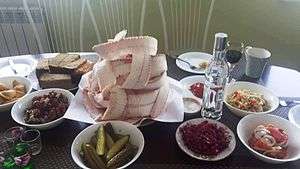Sakha cuisine
Sakha cuisine (Yakut: Саха аһа) encompasses the customary and traditional cooking techniques and culinary arts of Sakha. It is influenced by the area's northern climate and the Sakha people's traditional pastoral lifestyle, as well as Russian cuisine. Sakha cuisine generally relies heavily on dairy products, meat, fish, and foraged goods.

One of the most well-known Sakha dishes is stroganina, thin slices of raw, frozen fish. However, stroganina is also prepared using foal meat and liver.[1] This is eaten with a spicy seasoning from a flask. Another popular fish dish is indigirka, dish consisting of frozen fish cubes seasoned with onions, salt, pepper, and more.[2]
Milk is drunk and also used to make butter, curds, and a thick yogurt called suorat.
A popular dish is khaan, a type of blood sausage made from horse or beef blood and intestines.[3]
Kumis and vodka are both widely drunk among the Sakha.
One of the most popular desserts is kierchekh, a sweet dish made with cream, berries, and sugar, to which milk can also be added.
History
Although cows could only be milked during the beginning of summer, dairy products historically made up the most important part of the Sakha people's diet. In addition to drinking milk, the Sakha also used it to make butter, curds, kumis, and suorat. Meat, which was prepared boiled and without salt, was a luxury and usually reserved for feasts. Only sick animals were slaughtered and it was often consumed ceremonially.[4]
The Sakha also relied heavily on foraged goods. Traditionally, the Sakha ate pine sapwood, which was ground and then mixed with milk to form a sort of flour. Women gathered wild onions, berries, wild garlic, lilies, and various roots.[5]
Russian colonization brought with it bread, sugar, tea, vodka, and cultivated grains.[6] Mushrooms were consumed as food only after the arrival of the Russians, being previously only used for hallucinogenic purposes.[7]
References
- "Traditional Yakut dishes: From tongue to tail". Retrieved 28 March 2020.
- "INDIGIRKA SALAD". Russia Travel. Retrieved 28 March 2020.
- "Traditional Yakut dishes: From tongue to tail". Retrieved 28 March 2020.
- Jordan, Bella Bychkova; Jordan-Bychkov, Terry G. (2000). Siberian Village: Land and Life in the Sakha Republic. University Of Minnesota Press. p. 48. ISBN 978-0816635696.
- Jordan, Bella Bychkova; Jordan-Bychkov, Terry G. (2000). Siberian Village: Land and Life in the Sakha Republic. University Of Minnesota Press. p. 54-55. ISBN 978-0816635696.
- Jordan, Bella Bychkova; Jordan-Bychkov, Terry G. (2000). Siberian Village: Land and Life in the Sakha Republic. University Of Minnesota Press. p. 39. ISBN 978-0816635696.
- Jordan, Bella Bychkova; Jordan-Bychkov, Terry G. (2000). Siberian Village: Land and Life in the Sakha Republic. University Of Minnesota Press. p. 35. ISBN 978-0816635696.